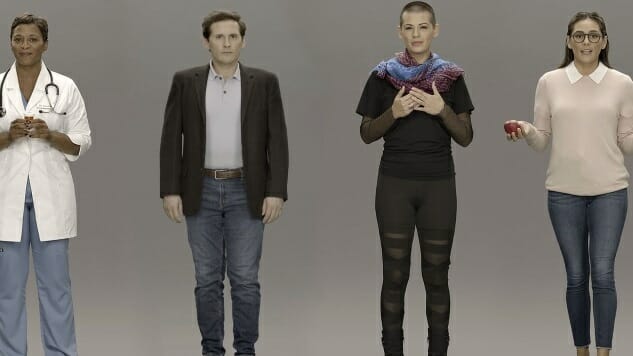Samsung’s Neon “Artificial Humans” Sum Up the Empty Hype of CES
These People Aren't Real. Neither Is the Hype.
Screen capture from the Neon.life site Tech Features CES 2020
In the weeks before CES 2020, Samsung’s Neon project had one question: “have you ever met an ‘artificial’?” As devised by the company’s secretive STAR Labs subsidiary, these “artificials” seemed to promise a lifelike AI that was indiscernible from real life. When they were finally unveiled at CES last week, though, they left people asking a different question: is this it?
Neon broke out as the clear leader in CES hype before the show even started last Monday morning. Not only was it promising innovations in a buzzy tech sector, or capitalizing on the secrecy that surrounded STAR Labs (a name that evokes fantastic feats of superheroic science fiction for fans of DC comics and TV shows), but its booth had a prime spot near the main entrance of the show’s Central Hall, guaranteeing that almost everybody at the convention would walk past it at some point. That booth was ringed with portrait-style screens featuring life-size human avatars showing off the kind of service roles that Neon’s artificial humans could one day fill: a park ranger, a travel agent, a flight attendant, a pop star, a stubbled loner in a leather jacket and sunglasses (perfect for if the USA Network ever wants to reboot Renegade without Lorenzo Lamas), and more. It was an eye-catching display that certainly got a lot of attention.
The booth hosted regular presentations by STAR Labs CEO Pranav Mistry, who explained both the goals of Neon and how the tech behind it works. His buzzword-laden speech definitely made the CES crowds excited for this new technology, boasting that the computationally-generated Neons will be able to interact with you not simply as an Alexa-style digital assistant or chatbot, but like a virtual human, even developing emotions, intelligence and a personality through repeated use. STAR Labs didn’t really explain how it’ll work in practice, though, and the CES demos that can be found online (here’s one from CNET) show interactions that are slow, cold, and anything but human. It’s a far cry from the smooth, realistic videos playing on the Neon booth’s screens; as The Verge reports, Samsung and STAR Labs even acknowledge that the “scenarios shown at [their] CES Booth and in [their] promotional content are fictionalized and simulated for illustrative purposes only.”
Despite all the focus on Neon last week, there’s little reason to think it’ll ever actually match what’s seen in that promo content, or attain the goals that Mistry spoke about in the booth. They seem less like a human than a high-tech version of Clippy.
The Neons might not yet be the groundbreaking artificial life that Mistry is aiming for, but they’re still perfect avatars, in a sense, although in not a positive way. Neon sums up, as elegantly as anything else I saw at this year’s show, the greatest problem facing CES and the tech world. CES purports to be the trade show that debuts the tech that will become an every day part of consumer’s lives in the future, and it’s true that the show had countless examples of both consumer electronics and behind-the-scenes tech that will make some amount of impact on how we live. The things that grab the most attention at CES, though, and emerge with the most hype and press clippings, are usually projects like Neon: moon shots that will never quite hit their mark, or tech that’s so expensive or impractical that it’ll never really exist outside of labs or shows like CES. So much of what I saw at last week’s show was presented with a disclaimer that it’s just a concept, or performed so poorly compared to a company’s goals that it’s clearly far off from public use, or had such a limited use altogether that there’s no clear reason for it to ever actually exist. (Yeah, I’m talking about the toilet robot, and the ping pong robot, and yes, a bunch of other robots, too.)
There are too many projects like this at CES. Projects that aren’t close to being presentable, that aren’t close to serving an actual useful purpose, or never will. Projects that are only being shown for the hype and the press that they’ll soak up, the flashy yet impractical gimmicks that writers (and I realize I am currently guilty of that myself) love to write about. Projects like Neon.
Have you ever met an “artificial”? Well, odds are you’ll have to keep waiting quite a good while.
Senior editor Garrett Martin writes about videogames, comedy, travel, theme parks, wrestling, and anything else that gets in his way. He’s also on Twitter @grmartin.